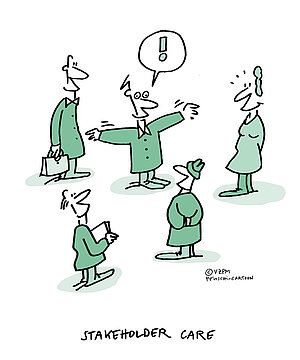Stakeholders
Definition
The stakeholders competence element includes identifying, analysing, engaging and managing the attitudes and expectations of all relevant stakeholders. All individuals, groups or organisations participating in, affecting, being affected by, or interested in the execution or the result of the project can be seen as stakeholders. This may include sponsors, clients and users, suppliers/subcontractors, alliances and partners and other projects, programmes or portfolios. Stakeholder engagement includes constantly revising, monitoring and acting upon their interests and influence on the project. Stakeholder engagement may also involve building strategic alliances that create organisational capacities and capabilities where both risks and rewards are shared.
Purpose
The purpose of this competence element is to enable the individual to manage stakeholder interests and influence, to engage stakeholders and to effectively manage their expectations.
Description
Stakeholder engagement is an ongoing process, taking place throughout the lifecycle of the project. Stakeholders are the partners for and through whom the project will achieve success. Stakeholders’ expectations, needs and ideas create the need and form the basis for the project. Stakeholders’ money and resources are necessary inputs and stakeholders use the outcome.
Stakeholders come in various forms and groupings (e.g. higher management, users, suppliers, partners, pressure and special interest groups, etc) and have varying attitudes, interests and influence. Therefore, each stakeholder or stakeholder group has different information needs. An engagement strategy – often laid down in a communication plan – is therefore essential. This strategy might be executed by focusing on both formal and informal communication channels as well as more involving forms such as alliances, collaboration or networks. Alliances are often documented and formalised through a contract document such as an alliance contract, or through the establishment of a joint venture entity. Collaborators may often be employed in separate parts within an organisation, or may comprise one or more different organisations. Networks have no clear power structure and hence are more difficult to engage with.
During the execution of the engagement strategy, the stakeholder environment should be constantly monitored for changes to ensure continuous alignment and improvement.
Key competence indicators
Identify stakeholders and analyse their interests and influence
The individual identifies all individuals, groups and organisations relevant to the project. The individual first has to analyse the attitudes of each stakeholder group and find out the reasons for these attitudes (the interests of the stakeholder in the project’s outcome or process). Secondly the individual needs to know the potential beneficial or harmful effect (influence) this stakeholder or group can have on the project. Their interests can come from various sources. For instance, because they may want to, or have to, use the project’s deliverables or because they are competing for scarce resources or budget. They can be great or small, positive or negative. In the latter case they are opposed to the project, for whatever reason.
A stakeholder’s influence can also be greater or smaller and may be concentrated in one or more areas (e.g. being able to supply or withhold funding, resources, office space and equipment, priority, access, etc). The individual should be able to make a stakeholder analysis at the beginning of each project, identifying stakeholders, their interests and influence. During the project, the individual should maintain an active analysis of the environment of the project, to identify new stakeholders, changed interests or changed influences. These changes in the stakeholder environment can be the result of changes in the project itself (e.g. going from a design to an execution phase). More often, they are the result of changes in the context of the project (e.g. organisational changes, personal changes in management, change in the economy, new regulations, etc). The individual should analyse the relevance of these changes for the project.
Measures
- Identifies the major stakeholder categories
- Identifies and names various stakeholders’ interests
- Identifies and evaluates stakeholders’ influence
- Identifies relevant changes in or around the project
- Analyses the consequences of changes for the project
- Takes actions in order to manage stakeholders
Develop and maintain a stakeholder strategy and communication plan
The individual will devise a stakeholder strategy – how to engage, keep informed, involve and commit the various stakeholders to the project and its objectives. This can be done by approaching each stakeholder, or group of stakeholders, differently, depending on their interest and influence. To make it manageable, stakeholders with similar interests and influence can be grouped together. The stakeholder strategy is often laid down in a communication plan, which describes for each stakeholder or group the why, what, when (and how often), how (through which communication channel), who (should communicate) and the level of detail of the communication. The ‘what’ is essential; the message should be tuned to the specific stakeholders’ expectations and should be aimed at committing each stakeholder to supporting (or at least not thwarting) the project.
The communication plan is central to expectation management. This can be summed up as the efforts of the individual to influence the expectations of the various stakeholders so that these come to expect and appreciate what (and when) the project can and will deliver and not become disappointed because of wrongly-held expectations about progress and outcomes.
Of course every communication is at least two-sided, so attention and care should be given to whether and how the sent communication was received, and follow-up should be given to feedback and other incoming communication.
As circumstances change, the communication plan should be regularly revised and updated. Potential alliances are developed and potential collaborators are identified. The benefits and outcomes of the potential partnership or alliance are identified for all parties. A relationship is established and developed with potential collaborators.
Measures
- Describes the importance of a stakeholder strategy
- Prepares a communication plan
- Adjusts the communication plan and/or strategy based on changed circumstances
- Explains reasons for changing a communication plan
- Identifies and evaluates opportunities for alliances and partnerships
- Identifies and evaluates potential collaborators
Engage with the executive, sponsors and higher management to gain commitment and to manage interests and expectations
For almost all projects the most important stakeholders include executives and sponsors. Often the executive is the supplier of funds (budget) and/or can decide on resources, priority of requirements, definition of scope, etc. With these primary stakeholders, expectation management is of the utmost importance. The commitment and confidence of the executive, higher management and/or sponsor(s) is of great benefit both to the success of the project and that of management. A good working relationship and open communication should be established.
Sometimes the roles are combined in one person, but more often different people fulfil one or more of these roles. They all have their own expectations, interests and influence on the project. Depending on the project, the executive and/or sponsor(s) can play their part in the stakeholder management and act as ambassadors, as they often have status and connections that the individual manager lacks.
Measures
- Engages management and/or sponsor(s)
- Manages expectations of the project’s executive, higher management and/or sponsor(s)
- Employs the executive and/or sponsor(s) to act as ambassadors
Engage with users, partners, suppliers and other stakeholders to gain their cooperation and commitment
For almost all projects, early and thorough involvement of users is a prerequisite for success. Users or their representatives can provide information such as needs and requirements and how the outcome will be used. This is often essential to the definition of each deliverables. Users or user groups may also provide resources.
Suppliers can provide the project with resources, knowledge, subproducts, etc. Care should be taken in choosing the best providers, especially if the knowledge, resources and/or sub-products can only be obtained from outside the organisation and formal contracts have to be closed to obtain these.
Partners are people, groups or organisations that cooperate to jointly deliver part of the deliverables, or they may make a broader contribution to achieving project objectives. These partners may only join efforts for a specific part, or they may work together on a more permanent, alliance basis. Partners may also be other managers with whom the pace, or deliverable content, of this project has to be tuned to optimise the benefit for the organisation.
When the project has a steering committee, one or more senior users or user representatives, senior suppliers or supplier representatives are part of that committee. Users and other stakeholders may be part of a sounding board that advises the executive or steering committee. The individual has to focus on these stakeholder groups from very early on in the project, and use his or her influence to select the right user representatives and suppliers.
Measures
- Engages users and commits them to the project
- Commits suppliers to the project
- Cooperates with partners to deliver the optimal result for the organisation
Organise and maintain networks and alliances
As part of the stakeholder strategy, networks and alliances can be implemented. These can be both formal and informal. When they are formal, agreements are negotiated and documented and a plan for ongoing cooperation is developed and implemented. As part of this plan, performance measures are identified and an exit strategy is developed.
All networks and alliances should be evaluated frequently and improved when necessary. Alliances can be ended by design, or because the formal relationship is no longer beneficial to the constituent organisations or stakeholders. Often, the organisation is quite likely to want to establish alliances with the same partners for new ventures in the future, so the ending of a formal relationship needs to be handled carefully.
Networks are more informal and tend to be sustained beyond the lifecycle of the project.
Measures
- Negotiates and documents the alliance agreement
- Develops and implements a plan for cooperation
- Develops and evaluates measures for success
- Maintains key partnership agreements
- Closes all formal contractual agreements


